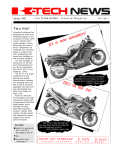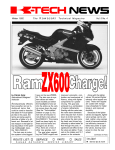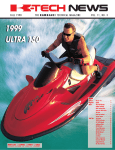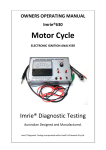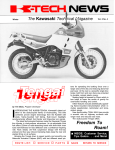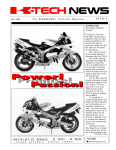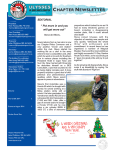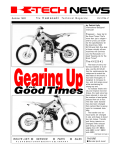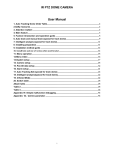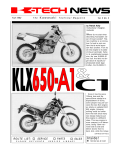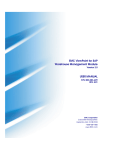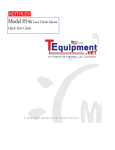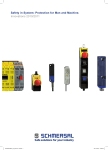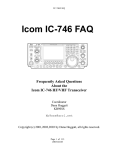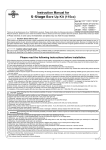Download K-Tech News Vol. 6 No. 4
Transcript
The Kawasaki Winter 1993 Technical Magazine Vol. 6 No. 4 by Walter Rainwater South & Central Region Instructor I recently had the opportu- The expansive Kawasaki Motors Manufacturing (KMM) plant in Lincoln, Neb. K-SHARE K-SHARE on line warranty claim processing by Patrick Kelly Instructional Designer/ Instructor essed through the K-Share system, parts handling goes from 10 percent to 25 percent. Paper claims will con- tinue to receive the 10 percent handling allowance. Good Times Protection Plan CONTlNUED ON PAGE 3 A s you are reading this, the new K-Share “on-line” warranty claim-processing system will be up and running. Even though many of you may already be using this system, we thought we would review how the system functions and its many features and benefits. Perhaps the biggest benefit of this system is the increased parts handling allowance. For claims proc- ROUTE LIST: o P L E A S E nity to travel to Kawasaki Motors Manufacturing (KMM) in Lincoln, Neb., with our Service Contest Grand Award winner Gary Bustillos. As you may recall, Gary’s award was a fully expense paid trip to his spectacular facility, and I thought K-Tech News readers would enjoy reading about the many interesting things we saw there. First, let me give you a little history: Kawasaki Moors Manufacturing was established in 1974, Kawasaki becoming the first Japanese vehicle manufacturer to establish a manufacturing facility in the United States. Since then, KMM’s eastern Nebraska factory has continued to grow and expand; today it employs almost 1,000 people. You may remember celebrating KMM’s production of its one millionth vehicle when a 1991-model JS650 rolled off the assembly line in August, 1990. Many were surprised to learn then that KMM manufactures not only motorcycles, but also ATVs, JET SKI® watercraft and utility vehicles, producing an average of 450 to 500 total units a day. In fact, KMM builds 27 different versions of Kawasaki vehicles for export to countries around the world. CONTlNUED ON PAGE 2 SERVICE R E T U R NT O o PARTS S E R V I C E o L I B R A R Y SALES Inside! n Service tips & more! KMM tour ... CONTlNUED FROM PAGE 1 The plant was recently expanded to accommodate the manufacture of the new ST watercraft, plus construction of a 110,000 sq. ft. addition is underway now, with completion scheduled for the first of the year. As Gary and I toured the plant, we were not simply looking at people bolting together vehicles on various assembly lines. We learned about some of the more interesting technicalities of modern manufacturing, and I’d like to share with you some of the fascinating things we saw. One of the first things you notice at KMM is the widespread usage of robots. This is not surprising, since Kawasaki Heavy Industries (KHI) is a leading producer of industrial robots. Robots are everywhere! In the watercraft area, robots are used for many tasks including applying the adhesive to (ABOVE) Custom-made press for producing watercraft hulls has a 3,000-ton capacity! (BELOW) Superior-quality wheels emerge from an intricate process. 2 K-Tech News l the hull and deck as they are joined together. A particularly impressive example of robotic technology is the machine that cuts all openings in the watercraft hulls. Its hole-cutting tool is a 40,000 psi jet stream of water. It was amazing to watch it cut holes in hulls, like the one for the exhaust outlet, so quickly and accurately! Then there is the press that makes the SMC hulls. It is gigantic, with a capacity of 3,000 tons! When KHI discovered it needed a press of this size, there wasn’t one available anywhere in the world, so Kawasaki engineers designed and built one themselves to suit their unique needs. The molds used in this press to make Kawasaki’s watercraft hulls are a two-piece design and weigh 150,000 Ibs. It was fascinating to see the array of 70-ton molds (one for each hull style) lined up next to the even more enormous press. Other manufacturers now using molds nearly this size need about eight hours to change molds in their presses; personnel at Lincoln can change molds in less than one hour. Everything about this press is huge, including the price: The press itself cost approximately $6 million while the molds run between $1 and $2 million each. KMM receives shipments of SMC material about twice a week. Every batch is checked for quality and glass content. A machine cuts the SMC material automatically and a worker places the pieces on a form. A robot picks up these cut pieces and places them on the mold in the press. (A robot is used for this dangerous job because the molds are heated to 290 degrees.) After the cured hull piece leaves the press, it goes to a worker who trims off excess material with a diamond-tip saw. As with everything else here, Kawasaki uses stateof-the-art equipment for making its components. Take ATV wheels, for example: Each wheel starts life as a flat piece of steel that is rolled into a tube and welded in a machine. Another machine shaves the weld on both sides. (Except for heat discoloration, the weld area is completely undetectable.) Still another CNC (which stands for “computerized, numerically controlled”) machine At spins the tube into a wheel. The spinning process makes the metal harder and stronger. The center section is then welded in and every wheel is carefully and individually examined for porosity. This superior quality is why Kawasaki also makes ATV wheels for Honda and Polaris. Robots do a lot of welding at KMM. Robots weld all the frames, footpegs, luggage racks, and the like. Some pieces of the aluminum frame for the ZX-6 are tack-welded by a human worker, but a robot finishes the job. After welding and cleaning, all Kawasaki frames receive a protective coating of paint. The black frames on MULES and ATVs are emission-free Ecoat-painted and powdercoated for extra durability. The assembly lines are wild: On the ATV line, for instance, the frame starts with a production tag attached. This tag is colorcoded, indicating the particular country for which the vehicle is destined. Parts bins behind each assembly line worker are also color-coded so they can select and install cycles are run until the cooling fan turns on. An inspector checks for coolant leaks, then the bike is dynotested and the speedometer checked. After each vehicle is passed, it is wheeled to the crating area. Gary and I were overwhelmed by the many amazing things we saw at the Lincoln plant-incredible machines like the ones that nail and staple crates together, or the ones which bend handlebars. The plant even has its own facility for recycling cleaners and solvents used in the various manufacturing processes. If you are ever planning to be in the area, I urge you to have your dealer call beforehand and make arrangements for you to visit the Lincoln plant. It will make you proud to be a part of the Kawasaki family. o K-SHARE K-SHARE CONTINUED FROM PAGE 1 KMM, robots abound! the correct parts simply by matching colors. All the KLF220, KLF300 and KLF400 engines, incidentally, are manufactured in another Kawasaki plant located in Maryville, M O., roughly 100 miles away. We watched several fuel tanks being welded and individually pressure checked. Some ’94 model tanks are made with steel that has a galvanized coating to prevent rust. In the paint department, fuel tanks are finished with two coats of color. After the paint dries, decals are applied before a final clear coat goes on. All KMM-produced vehicles are run at the end of the assembly line. Motor- claims will continue to be reimbursed at retail for parts plus a 10 percent incentive bonus on the entire claim regardless of whether they are filed by K-Share or through the mail. Speed is another benefit of this new system. The length of time between filing a claim and getting reimbursed for the claim can be greatly reduced in most cases. It is our intent to process all claims on the day they are transmitted, so it’s possible to submit a claim and receive credit the very next day. Of course, in order for that to occur, the warranty claim must be a valid one and the claim must be filled out correctly. The system checks each claim for technical accuracy before assigning it a claim number and sending it to a warranty analyst for review. If the claim has a technical error (such as missing or incorrect information), the system will notify you that the claim is in error and will highlight the fields where the errors occurred. Once the error-free claim is received by Kawasaki, it is reviewed by a claims analyst who will determine if additional information is required. If it’s determined that the claim can be paid without any additional information from you, your parts account will be credited that night. The K-Share warranty claim system offers greater convenience, too. For example, Good Times Protection Plan claims no longer require you to send in a copy of the work order. (You should keep these copies on file, however, in case we request them.) If we do request that any paper document or parts be returned to us, that’s now easier because the system allows you to print mailing labels with all pertinent claim information on them. If you are sending in parts for more than one claim in the same box, be sure to include copies of all applicable claims. Oh, and don’t forget to tag all returned warranty parts with the Kawasaki part tag, P/N 99995-407. The rest of the system remains much the same as the one we’ve been using for years. But now you can process your claims faster, more conveniently, and receive more credit for it, too! o The Technical Magazine 3 l Winter 1993 Vol. 6 No. 4 ©1993 Kawasaki Motors Corp., U.S.A. (KMC). All rights reserved. In search of ... service-related materials by Ray St. John K-Tech News Staff Supervisor, Tech. Writing Publisher Kawasaki Tech Services I f you’ve ever had to stop work just to wonder where you were supposed to go to get service manuals, blowup posters, a list of owners manuals, part numbers for A&P sheets or the like, you’re not alone. Sometimes it seems there is a different way to go about getting every different Kawasaki publication. In truth, though, there are just a few basic ways to get “stuff” from KMC. One way is to use its part number. Another is just to “give us a call.” You can get anything with a part number on it by ordering using that number except for a few posters that are imported by the Technical Training Department. These have part numbers on them that are used by Kawasaki in Japan and select other markets but not in the U.S.A. By calling, you can get any Kawasaki technical publication you want. If we don’t have a way to get it for you, we’ll tell you straight out. But usually, if you want it and you call us, we’ll find a way ... Here, though, is some more specific advice: Publications Manager Don Church Executive Editor Gary Herzog Editor-in-Chief Gregg Thompson Communications Editor Patrick Kelly Regional Editors North and East Fred DeHart Central and South Walter Rainwater Contributors Randy Davis, Jerry Heil, Donna Hood, John Pomo, David Pyle, Ray St. John Graphics/Production Graphic Art Gregg Thompson Copy Editor Pat Shibata Production Nickless Communications Published by Kawasaki. All suggestions become the property of KMC. Sending a service suggestion gives Kawasaki permission to publish and/or use it without further consideration. Specifications subject to change without notice. 4 K-Tech News l Order by part number. Just look at the back of the book, near the bottom. If you don’t have a copy of the book to look at, refer to grid A-2 of the parts microfiche for the model in question. Most Kawasaki service manuals (those produced during the last 10 years or SERVICE MANUALS so) have part numbers that begin with “99924.” The last two numbers (like -01 or -02) are edition numbers. The higher the number, the more up-todate the book. If you order an -01 and get an -02, you have what you need, just a newer edition. NOTE: Service manuals now ship with a list detailing what books you should have to take care of the last five years of street motorcycles, three years of off-road bikes and ATVs, and all watercraft and generators. Review this to see if you’re properly equipped. (And see the Fall ’93 issue of K-Tech News, Vol. 6 No. 3, for a discussion of service manual supplements. -Ed.) Same as Service Manuals, except that the part numbers usually start with “99920” and there’s no master list. OWNER’S MANUALS This publication tells you how to put a product together and prepare it for retail sale. A&P manuals are available for all motorcycles, ATVs, watercraft, and utility vehicles. About once or twice a year, we send an A&P materials index which provides you with the part numbers of all current instructions. For motorcycles and ATVs, there is a general A&P manual that covers all models and a supplement for each individual model. Because the crating generally doesn’t change much, some A&P supplements were originally issued for the first A&P MANUALS year of a model now in its fifth or sixth year, and they’re beginning to look dated. Don’t worry. They’ll give you all the info you need to do the job right. For now, the watercraft and utility vehicle models each have their own A&P manual, though a general A&P manual for watercraft with supplements for individual models is in the works. TECHNICAL TRAINING POSTERS, VIDEOS, AND MANUALS These are the items you need to call to get. Kawasaki’s corporate number in Irvine, Calif. is (714)770-0400. Use ext. 2472; we’ll process your order quickly. Training service bulletin TR93-02 (dated Oct. 1, 1993) lists all Technical Training Video Tapes available; TR93-03 (July 16, 1993) lists all Technical Training Posters; TR93-05 (Oct. 1, 1993) lists all Technical Training Manuals and Video Reference Guides. Use these to order what you need for this winter’s training season. SPECIAL SERVICE PUBLICATIONS Training Service bulletin TR93-04 (dated Oct. 1, 1993) lists the Service Specifications Handbooks for motorcycles and watercraft, and the Model Recognition Manuals. These books all have part numbers. Order them just like you would a service manual. That’s about it. The one thing you need to know in the end is: If you have any questions, give us a call. We’re here to help. o KLX650 “pass” or fail Info feeding frenzy by David Pyle, Park Publication Specialist by David Pyle, Parts Publication Specialist Wow! We had a lot of activity at the Micro-K booth at While hunting for the the Kawasaki dealer meeting in Dallas. The new MR-1 microfiche readers were very popular. We also set up quite a few dealership service departments with Micro-K decks and subscriptions as well. Even though the sale is over, the prices for Micro-K equipment have been held so they remain the same as shown on Parts Bulletin GEN 92-02, dated May 22, 1992. (This bulletin has more important information included on it as well.) The most common questions asked at the show concerned availability of bulbs for the Microfiche readers and Microfiche storage units. Kawasaki stocks these products along with many other microfiche components in all of our distribution centers. Part numbers and prices of the available items can be found on Parts Bulletin Gen 92-02. Order any of these items the same way you order all your spare parts from K-Share or from your master warehouse. I really enjoyed meeting and talking to so many of you at the Dealer Meeting. Along with you, I look forward to a great year in ’94! P.S. We had a couple of requests at the dealer meeting for printed parts catalogs for KX models, so we looked into it. There is enough interest (i.e. retail potential) to offer them. And so, we are offering printed catalogs for all ’94 KX, KDX and KLX models. Refer to Parts Bulletin MC93-01. o l 1994 KX Jet Needles I t’s time again for the annual KX jet needle explanation and chart. As usual, there is no information on the microfiche to help you figure out what needle to order if you want a richer or leaner one. Each model has two groups of needles available with five needles in each group. For each model, these groups are just 1/2 clip position different from each other. For example, on the KX125 the N1JM needle (from the N1J_group) is 1/2 clip position leaner than the OEM standard N1KM nee- dle (from the N1K_group). The jet needle chart in the owners manual does not list the needles in a true “Leanest-to-richest” order because it doesn’t take into consideration this halfstep difference between the two groups. The chart at right lists the available needles for each model in the correct order, from leanest (top) to richest (bottom). Keep in mind that each needle is only 1/2 clip position different from the one above or below it on the chart. Refer to the microfiche to get the part number of any headlight relay diode in the new KLX650 (see that article on page 6), we stumbled across an interesting little feature of the KLX headlight system: There is a “PASS” switch on the back side of the LH handlebar switch case. We found that when you operate that switch, battery power is routed from a chassis (brown) power lead around the headlight high/low switch to the R/Bk lead going to the high beam. The obvious purpose of this switch is to momentarily turn on your high beam while you ride along at night with your low beam on. As long as the dimmer switch is on “Lo” and the pass switch is pulled to the on position, both elements in the headlight will be on. Reneedle you want to order. The “ * ” indicates the standard needle. P.S. The jet needle chart for the ’93 models printed in K-Tech News lease the pass switch to return to using just the low beam. But there’s more: Since the pass switch takes power from the brown wire (which is hot any time the ignition switch is on), it allows you to turn on the headlight with the engine stopped. If the dimmer switch is in the “Hi” position when you do this, the power will go backwards through the dimmer and up the BIN lead to the headlight relay diode, activating the relay-and the headlight will stay on, even when the pass switch is released. If the dimmer switch is in the “Lo” position, the headlight will go off when you release the switch. o last year was taken directly out of an early owners manual and was incorrect. We’re sorry about that. - Gregg Thompson 1994 KX Jet Needle Chart KX125-K1 Leanest N1JO KX250-K1 N1KO N1KN N82R* N1KL N82Q N89E N1ED N82P NOZC N1KK N89F N1EE* NOZD N1JK N89G N1EF N1KM* N1JL Richest N82S NOZE N1JM N89H N1EG NOZF N1JN KX500-E6 N82T NOZG N1EC N89D The Technical Magazine 5 l KLX650 headlight diode explorations by David Pyle Parts Publications Specialist When replacing the volt- Whether you are looking for the part number on the microfiche or for the part itself on a bike, you will have a hard time finding the KLX650-C headlight relay diode. This diode is the one integral to the system that automatically turns on the headlight once the engine start button is released. On Kawasaki street motorcycles, this diode (or diode pack) is normally located in the junction box. But not on the KLX650. On this bike, it is neatly wrapped inside electrical tape on the main wire harness just below the headlight relay. The headlight relay is mounted on the headlight bracket just behind the headlight, and once you’ve found the relay, it’s relatively easy to find the diode. There will be a bulge in the wire harness 2-3 inches below the headlight relay. That’s the diode. Unwrap the tape and you’ll find the diode mounted in a harness connector. The connector has a one-way hook that has to be probed with a pick to release the diode. At the time I’m writing this article, finding the diode on the microfiche is even harder than finding it on the bike. That’s because it’s not on the current microfiche ... This will be corrected on the next revision. If you need one before that arrives, the part number is 49018-1059 and they are in stock. o 6 K-Tech News l ® Ninja alternator repair age regulator in any of our larger Ninjas, from the 750s up to the 1100s, care must be taken reattaching the power supply to the regulator. This is usually a brown wire and is at- KLX650 stars in Baja 1000! I t required more time than anticipated to design, fabricate and assemble some of the wildly exotic aftermarket components and sub-systems. At least one of its riders professed a preference for the vastly more developed KX500. Nonetheless, Kawasaki’s Team Green racing department really showed off its incredible off-road racing prowess, not only with an unprecedented sixth consecutive overall win in the lateNov. ’93 Baja 1000, but also with the amazing performance of its brand new KLX650. Ridden brilliantly by off-road veterans Paul Krause, Garth Sweetland and Ted Hunicutt Jr., the state-of-the-art fourstroke machine finished third overall in its Baja debut! Team Green hand-fabricated everything from clutch housing to lighting system to spaceage exhaust system on the prototype 650, which ha! shown extremely well in its first season of competition. We’ll have more in the next issue of K-Tech News. - S. Nickless ALERT KLF300 Igniter failures A couple of dealers have reported to us that failed KLF300 igniters may have been caused by high voltage from a bad regulator. In each case, the dealer had replaced the igniter to correct a no-spark condition. Shortly after the first repair, the vehicle came back with no spark again. This time, technicians at each of these dealerships checked the charging system and found that it was charging at very high voltage (16-18V at the battery when revved up)! it is conceivable that high voltage in this system could have damaged the igniters in these cases. It's probably best to do a quick chargingvoltage test whenever replacing an igniter on a KLF300. See page 9 of this issue for more KLF300 ignition/charging system info. - Ed. tached to the “IG” terminal. In this “field excited”type alternator, this power lead can easily be attached to the “F” terminal (located very close to the “IG” terminal). The “F” terminal even has a screw identical to the one on the “IG” terminal. Simply put, if you attach the power lead to the “F” terminal, the regulator will be rendered useless (smoked) the moment you turn the ignition switch on. We know of several cases where the dealership technician correctly diagnosed a bad regulator but connected the power lead to the “F” terminal on reassembly. When the alternator still put out no power (the regulator was dead again), the technician replaced the entire alternator thinking there was something else wrong with it that was causing it to “eat” regulators. That’s a very expensive and unnecessary repair caused by a very small error. - Jerry Heil Camchain tensioners for early 900s/1000s Rear axle torque: Important? Yes! I n the Winter 1992 issue by John Pomo, Product Support Specialist of K-Tech News, we printed an article telling you about a newer, sturdier camchain tensioner for the ZX900A through ZG1000 engine family. When the older, screwstyle tensioner weakened and became noisy with age, we explained, it could be replaced by the latest ratchet-type tensioner from the ZX11. But since then, we have received a few reports noting that when this modification was tried on some older models, it resulted in abnormal camchain noise. This puzzled us because the newer tensioner has plenty of spring pressure and more reach than the older tensioner. Well, the problem seems to be with higher mileage units and is apparently the result of a poor fit between the flat end on the new-style tensioner and the concave surface on the old camchain guide. So we must amend the original article: When replacing an older (screw-type) tensioner with the ZX11 (ratchet-type) tensioner, make sure the old one has a flat end cap. The early style tensioner used in most of the ‘84-87 engines in this family has a rounded end cap that fits into a concave area on the chain guide. By mid’87, though, the factory had begun using another screw-type tensioner which had a flat end cap. The camchain guide in these later-model engines had a convex surface to mate with a flat end cap on the tensioner. That particular tensioner was eventually replaced by the current ratchet-style component which has a similar flat end and uses the same camchain guide. This newest tensioner doesn’t always work well with the original style (concave) camchain guide. So what’s the bottom line? If the tensioner you are replacing has the rounded end cap, replace the camchain guide also in order to insure proper function of the new ratchet-style tensioner. Our thanks to the Concours Owners Group (COG) and their Concourier newsletter staff for alerting us to the possibility of problems when converting to the newer-style tensioner. - Ed. When a motorcycle’s rear axle has been loosened for any reason (changing the rear tire, adjusting the chain, etc.), torquing it properly on reassembly is very important on any model. But, on some chain-drive models, the consequences of not tightening the rear axle to the proper torque can be worse than you might think. Models with the aluminum box-section swingarm with the chain adjuster located inside the end of the swingarm tubing (such as the ZX750-H1 and ZX600-D and -E) are susceptible to a unique failure if the axle is not torqued properly. The lightweight chain-adjuster cap on the end of the swingarm was designed to withstand only the light pressure applied when adjusting the chain with the axle nut loose. If the axle nut isn’t torqued properly, the axle will be pulled forward during hard acceleration, easily breaking the chain adjuster cap by pulling the adjuster bolt right rough it. The axle will continue to move forward on the left side cocking the wheel to the right until the chain finally climbs off the rear sprocket. In case you were wondering, the chain coming off the rear sprocket-especially under hard acceleration— is not a good thing. We think its a real good idea to check the service manual for the correct torque when tightening a rear axle. Then use a torque wrench to make sure it’s right. You might be surprised at how much torque is required: The ZX600-E manual, for example, calls for 80 ft/lbs! Try applying that much torque with your handy dandy Crescent wrench! If you have any customers who regularly do their own service work and whose motorcycles have this type chain adjuster, you should probably pass this tip along ‘them. o The Technical Magazine 7 l MULE™ usage-triggered rear axle modifications by Randy Davis, Product Quality Engineer S ome time after the first MULE™ utility vehicles became available in 1988, we began receiving reports from customers who had problems with rear axles mysteriously pulling out of the differential. Though infrequent, these reports were quite troublesome due to the nature of the failure and the fact that the failure would sometimes repeat on the same unit after the repair was made. Well, we still haven’t discovered the cause of this strange failure, but we beeve it is aggravated by rough or hilly terrain and/or heavy vehicle loads. Our belief that this is related to usage is substantiated by the fact that while the failure rate is extremely low, we have several cases of repeat failures even after all related parts have been replaced. If you are dealing with one of these repeat offend ers—and there are known cases affecting most MULE models, from the 1000 to the 2510—you may want to consider performing some surgery to modify the axles in order to eliminate this problem. The modification we suggest requires removing the KAF450-B l In the case of the MULE 2010 and 2020 models, this modification will require splitting the cases in order to machine the left axle since there is no removable bearing holder ä KAF450-B KAF620-A,B KAF540-C,D 8 K-Tech News axles, machining them, and then reinstalling them with a different circlip usually in a different locaon) and a new collar that helps keep the circlip in the groove. KAF540-C,B KAF620-A,B on that side. On both the MULE 1000 (KAF450-B1) and the 2000-series MULES (KAF540-C1 and KAF540-D1), you will have to machine another circlip groove in each axle to accept the new circlip in a new location. On the MULE 1000 (KAF450-B1), you must also machine 1.5mm of material off one end of the differential lock shifter so it will clear the new circlip when its in the unlocked mode. On the MULE 2510 and 2520 (KAF620-A1 and -B1), you will have to remove some material from the shoulder that locates the bearing on the axle to make room for the new collar. FYI : The 2000 series and 2500 series rear axles are interchangeable. The drawings shown at left should give you all the information you will need in order to modify the axles to accept the new circlip and collar. NOTE: This modification should not be performed except when multiple failures have occurred on that unit. This article does not constitute a factory repair campaign and is not warranty authorization. o KLF300: Don’t knock these solutions We still get the occasional call from a dealer who is chasing his tail trying to find an elusive knocking noise in a KLF300. Most of the time when a dealer is chasing one of these phantom knocking noises, we on the Hot Line refer him to the article printed in the Spring 1992 issue of K-Tech News. But it now seems worth re-printing the article for those of you who never saw it or who have forgotten about it. So, here it is. -Ed. by Gregg Thompson, Product Support Supervisor I f you have a 1990 or just as described above. Apparently, the audible “knock” was the result of incorrect ignition timing at low rpm due to a faulty igniter. The knock worsened as the engine warmed up, which does make sense if the noise is the result of detonation. Hey, if you think the IC igniter remedy is a strange one, here’s an even more unlikely solution to the same problem: Several nits with the same Iowrpm knock also had a problem with the engine suddenly stopping at low speeds, bringing the vehicle to an abrupt halt. These units did not re- spond to replacing the igniters. After disassembling and inspecting the clutches, transmission and, in one case, even the engine, the problem turned out to be a faulty regulator/rectifier! That’s right: The knocking noise and engine stalling at low speeds was caused by a faulty regulator! So, if a vehicle shows up in your shop suffering from some of these symptoms, check the battery for high voltage in the 1618V range with the engine running or just plug in another regulator/rectifier. o older KLF300-B or -C model with a mysterious knocking noise at low engine rpm, the solution could be easier than you think. If the noise sounds just like a rod knock and is louder when the engine is hot, but goes away just above idle, why not try a new IC igniter? “Oh, that makes perfect sense!” you say. “Not!” Well, strange as it may seem, that was the solution in a a lot of cases where the symptoms were PARTS UPDATE Beware the changes in the VN750-A10 oil filter .. T here have been some previous VN750s. The o-ring changes to the VN750-A10 diameter is also smaller on oil filter and mounting plate the new filter and the oil filter that are not shown on the mounting plate is changed to correspond. Please be original microfiche. The ’94 model VN750- aware that the old and new A10 uses a P/N 16097-1064 filters do not interchange. oil filter. This new filter has a The revised microfiche is much smaller outside diame- dated Dec. 1993. ter than the filter used on all - David Pyle The Technical Magazine 9 l Generator high altitude jets MULE™ 2510 rattling front drive shaft by Randy Davis, Product Quality Engineer I f you’ve sold very many of the four-wheel-drive MULE™ 2510s at your dealership, you have probably had someone come in complaining of an annoying rattle in the front drive train that occurs only when the vehicle is in 2WD. If you’ve had this complaint but you haven’t come up with a solution yet, maybe we can offer some assistance. There is no official “factory fix” for this-the rattle is not considered “abnormal”-but we can offer some suggestions that will help reduce your customer’s irritation. The noise comes from clearance in the splines where the front propeller shaft connects to the pinion shaft on the front differential. We have found no way to completely eliminate the noise, but you can reduce it to an acceptable level by installing a thick rubber damper on the pinion shaft spline and by filling the splines themselves with a very heavy waterproof grease. The heavier the grease and the tougher the rubber damper, the longer the repair will last. You can order P/N 92075-1110, a thick rubber washer, from Kawasaki for the damper or you can chase one down locally. You can even make your own if you have some good material to use. The damper needs to be about 5mm thick and fit over the pinion shaft. Meanwhile, Bel-Ray waterproof grease seems to work very well in the splines. o Small pieces for KLF300s Good news! Until now, the U-joint couplers for the KLF300-C 4x4’s front drive shaft (which connect the subtransmission to the front differential) have only been available as assemblies. The rear one included the propeller shaft as part of the assembly. Well, we’ve finally managed to make all the small pieces for the U-joints and the propeller shaft available separately. As of today, the KLF300-C5/C6 microfiche is the only one showing these new part numbers (see Grid #D-4, Drive Shaft [Front]), but the parts fit all KLF300 models from Cl through C6. The microfiche for the earlier models will be updated as soon as possible. - David Pyle 10 ll K-Tech News Until recently, our Portable Generator microfiche have not listed any optional jetting information for high-altitude operation. The relatively new GE4300-AS and GE5000S microfiche do list alternate main jets for high-altitude se, but the altitude information is not real clear. Recently we received some high-altitude jetting specifications for all Kawasaki generators. We thought you might be able to make use of it, so here it is. (This table lists main jets only.) - Gregg Thompson Generator High Altitude Carburetor Adjustment Refer to the following main jet setting guide to get the proper mixture ratio for operation of generators at high altitude: MODEL KG550B KG750B KG1100B KG1600B KG2900B KG4000A KG5000A/B GA-, GD550A GD700A GA1000A GA1400A GA1800A GA2300A GA3200 GE2200A GE2900A GE4000AS GE4500AS GE4300A GE5000AS SEA LEVEL (std) 57.5 92063-2067 75 92063-2002 87.5 92063-2004 92.5 92063-2006 87.5 92063-2004 115 92063-2009 57.5 92063-2120 72.5 92063-2062 87.5 92063-2051 91.3 92063-2094 72 92063-2232 90 92063-2159 85 92063-2245 3,0006,500 ft. 55 92063-2007 72.5 92063-2062 85 92063-2097 90 92063-2081 85 92063-2097 112.5 92063-2008 55 92063-2121 70 92063-2059 85 92063-2087 90 92063-2052 70 92063-2233 87.5 92063-2238 82.5 92063-2246 6,500 ft. and up 55 92063-2007 70 92063-2059 82.5 92063-2003 87.5 92063-2004 82.5 92063-2003 110 92063-2092 55 92063-2121 67.5 92063-2065 82.5 92063-2054 87.5 92063-2051 68 92063-2208 85 92063-2192 80 92063-2247 CONTlNUED FROM PAGE 12 “We’ve” got the right manual, baby, uh huh!” by Donna Hood, Customer Service Representative It’s snowmobile season. A customer calls your dealership asking for an owner’s manual for a 1980 Invader. Your computer shows the manual has been discontinued. What can you do to help your customer? Call KMC Customer Services! We have access to a variety of literature that can no longer be ordered through the Parts Department. Listed below are items that can be obtained through Customer Services by either dealers or customers: l Current model brochures l Older model brochures, from 1980. Not all models are available. We have some original brochures, or can send a photocopy of the original brochure. l Accessory brochures for all models. l Warranty policies for all l Owners manuals for all models, including generators. We will photocopy the owner’s manual for an older model, if the manual is no longer available. Cost is free. l Service manuals for all models, including generators, available to customers directly from Customer Services. Cost: $24.95 for base manual, $10.95 for supplement, and $3.50 for postage. l Microfiche for all models. Cost: $2.00 each. l Snowmobile owner’s manuals. Cost: free; may be a photocopy of the original manual. l Snowmobile service manuals. Cost: $24.95 plus $3.50 postage. May be a photocopy of the original manual. l Reprints of magazine articles. CONTlNUED FROM PAGE 12 where prospective customers can take a test ride. Later in the summer, there is a “fun day” where the customers bring their watercraft for some friendly competitive events. Kawasaki of Ocala furnishes the refreshments. Jeff uses open houses with a variety of themes to help build customer loyalty. One theme is directed toward the off-road and motocross customers. This particular open house coincides with a motocross series in the region. An open house designed for the street rider takes place during the summer. ATVs and MULE S are put on display and test ridden on an outdoor track during the open house in the fall of the year. There are refreshments at all open houses. All 17 of the employees are motorcycle enthusiasts. They promote and take part in road rides with the customers. Sometimes the customers and employees go for a trail ride after work. Being in Florida, watercraft are always the nucleus of a good time between the customers and employees. Jeff’s plan to build customer loyalty is easy to understand: Help the customers to have fun on their Kawasakis. Does it work? You bet it does! This year, sales are double when compared to any year in the 28year history of the dealership! The “customer loyalty” idea is not new. You are probably thinking, “Why didn’t I think of that?” Well, you should be thinking: “I can do that. o l Service Specification Manuals. Cost: $6.95. models. Recognition Manuals. Cost: $12.95. l Sample l Good copies of the Good Times Protection Plan Policy. early. All that is necessary is to call your regional sales office and ask for the sales secretary. She will be happy to register you for the training class you wish to attend. I look forward to talking with you in class very soon. Remember, the busy season is just around the corner. Act now! o l Model l Jet Times magazines. Sports magazines. Cl You want it? Customer Service has it! - Brochures - Microfiche - Good Times magazines - Warranty policies - Owners manuals - Jet Sports magazines - Service Manuals - Article reprints - Good Times Protection Plan policies ... and more! CONTlNUED FROM PAGE 12 job in the amount of time the customer is being charged for, then your efficiency could use improving. Reviewing one of our training tapes and its accompanying workbook could help you improve your efficiency. Investing in some new tools could help make you “faster.” Attending a Kawasaki training school could make a big difference in your efficiency. Whatever you resolve, I hope your new year is a great one, and I hope to see you in a training class soon! o The Technical Magazine 11 l R E G I O N A L N E W S Training Schedule East Region January 11-13 Engines Modern Engine Theory 14 25-26 MULE™ Service 27 Generator February 8-10 JET SKI® Watercraft Service Department Operations 15 16-17 Team Green Race Preparations 23-24 Fuel Systems Parts Department Operations 25 North Region January 17-19 JET SKI® Watercraft Modern Engine Theory 20 21 Generator February [No classes scheduled] WEST SOUTH & CENTRAL NORTH & EAST Resolutions Loyalty Sign up early by Patrick Kelly 9950 Jeronimo Road Irvine, CA 92718 (714) 770-0400 by Walter Rainwater 6110 Boat Rock Blvd. SW. Atlanta, GA 30378 (404) 349-2000 by Fred DeHart 201 Circle Drive N., #107 Piscataway, NJ 08854 (201) 469-1221 I t’s time for you to start thinking about your New Year’s resolutions. What are they going to be? I’ve got a couple of suggestions for you: How about resolving to improve your job skills! If you’re a technician, this would mean improving your productivity and efficiency. Productivity is a measure of how many hours you spend during the day “clocked on” a work order. Improving your productivity means less time wasted between work orders. Consciously try to limit the amount of time you “waste” between jobs can help you improve your productivity. Efficiency is a measure of how much time it takes you to do a given job vs. how much time the customer is being charged for. If, on the average, you are not completing a given Jeff Lewis owns Kawasaki of Ocala. After working for another dealer for eight years, Jeff decided he wanted a dealership of his own. This he was finally able to purchase in April 1992. Based on his prior working experience, Jeff knew that customer loyalty was one of the secrets to a successful business. Jeff and his employees set about building customer loyalty in many ways. Kawasaki of Ocala is a Team Green dealer. They have a contingency program for 35 riders and plan on supporting as many as 50. One of their employees goes to the local motocross races with their version of the Team Green Support van and provides technical support and parts for their racers. In the spring, Jeff holds a demo day for watercraft I have gotten good reports from riders who have had the chance to ride our 1994 KX models. If you want to learn more about the new motocross machinery and get solid advice on rebuilding front and rear Kawasaki suspension systems, be sure to attend this training season’s Team Green class. Team Green classes are only held once each training season. We will hold one in the North Region and one in the East Region sometime near the end of Feb. or March ’94. Specific dates have not yet been finalized so be sure to check upcoming issues of K-Tech News and the training bulletins that are sent to your dealership every month. Fall classes, held through Dec., filled rapidly so if you plan to attend in the future, try to sign up CONTlNUED ON PAGE 11 CONTINUED ON PAGE 11 12 K-Tech News l CONTlNUED ON PAGE 11 March 28-29 MULE™ Service 30-31 Team Green Race Preparations April Service Department Operations 1 Central Region February Precision Measurement and 22 Diagnostic Tool Usage 23-25 JET SKI® Watercraft 28 Generator March 1 Fuel Systems Troubleshooting Electrical Systems 2-3 South Region January Service Department Operations 13 17-18 ATV Service Tune and Service 19 Precision Measurement and 20 Diagnostic Tool Usage 24-25 MULE™ Service 26-27 TroubleshootingElec.Systems Modern Engine Theory 31 February 1-3 Engines 7-8 ATV Service 9-10 Team Green Race Preparation 14-16 JET SKI® Watercraft 17 Generators West Region January ATV Service 13 18-20 Troubleshooting Elec. Systems February 1-2 MULE™ Service ATV Service 3 7 Precision Measurement and Diagnostic Tool Usage 8-9 Engines 10 Generator 14-16 JET SKI® Watercraft 17 Service Department Operations 22 Fuel Systems Modern Engine Theory 23 24 Tune and Service












